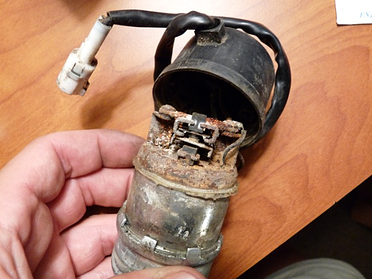Is your fuel filter blocked, or has your fuel pump gone bad?
Especially while riding in countries with low-quality fuel, many motorcycle travelers will at some point be parked along the side of the road trying to figure out what is wrong. Are your filters blocked with sediment, or has the fuel pump itself actually gone bad? Here we help you through a process of elimination to get you back up and riding as soon as possible.
Fuel is Flowing?
It’s important to check the flow of fuel between the tank(s) and the fuel pump. Using the KTM 950 Adventure tank in the picture shown, we were able to confirm by opening the shut-off valve that plenty of fuel was flowing past the in-tank fuel filters and into the line that run to the fuel pump. Of course if the fuel was barely dripping out or not flowing at all, cleaning or replacing the in-tank filters would be first on our “to do” list. Because the in-tank filters are the only filters in this fuel system, we know that plenty of fuel is getting to the fuel pump. 
The Fuel Pump is Pumping?
Also make a point to listen closely to the fuel pump. On most bikes these days with diaphragm-type fuel pumps, the pump will prime itself every time you power the motorcycle up. With the ignition key “ON,” then flip the engine cut-off switch on your handlebar to the “ON” position. Listening closely, (it can be difficult to hear) try to determine if the fuel pump “pumped” itself 5-10 times as it would to prime itself for operation. If you didn’t hear anything or maybe only 1 quick “pump” sound, then you’ve pretty well isolated the problem. The likely situations are A) you have an electrical failure or break in the circuit that brings power to the fuel pump, B) especially on exterior-mounted pumps, the electrical inner-workings of the pump itself have failed due to corrosion or just wear and tear, or (see below) C) some other kind of failure is taking place with related to the pump.

Electrical Inspection
Hopefully you’re familiar with how to use a voltmeter or some type of power-testing unit to confirm if the pump is even receiving the electricity necessary to do its job, and how to find the right checkpoints for your motorcycle. If the pump is not receiving electricity, think about things like loose or corroded connections, broken wires, blown fuses, and anything that would interrupt the flow of electricity. Many diaphragm pumps will work with a system of electrical contacts within a pump housing that might be corroded, or just worn down and not able to make “contact” correctly. A contact-cleaning spray, or some light scraping or filing of the contacts might prep the contacts well enough to get the pump working again, but if the contacts themselves are worn down or non-existent after miles and miles of use, no electrical connection will be made and the pump will not run. Maybe the contacts can be replaced on your bike’s pump, but it’s also possible that the entire pump needs to be replaced.
Please keep in mind, these guidelines this process of elimination won’t apply to all motorcycles. Our hopes as always are that you find this information useful enough to get you back on the road or trail soon!


